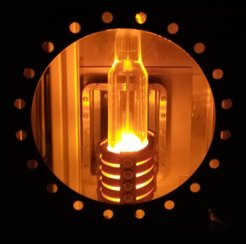Thermal Desorption Spectroscopy
TESS

The TESS experiment (thermal effusion spectroscopy setup) allows samples to be heated in ultra-high vacuum in different ways. Gaseous inclusions are mobilized and can be detected using a mass spectrometer. The methodology is mainly used to detect deuterium. Unlike the nuclear reaction analysis, no depth information is obtained, but the total amount of deuterium contained in the sample can be determined - even if the deuterium comes from larger depths of the sample than accessible which the nuclear reaction method.
At the same time, one learns something about the binding energy from the temperature at which the deuterium leaves the sample and thus indirectly about the defects in which the deuterium was stored.
A special feature is the possible UHV connection to the ROST high-temperature furnace. It allows desorption measurements up to a sample temperature of 3200 K. Furthermore, a high-resolution mass spectrometer allows the separation of deuterium (4.028204 amu) and helium (4.002600 amu) with a mass difference of only 26/1000 atomic mass units.
ROST

The ROST experiment (Radiofrequency Oven for Solubility Tests) uses inductive heating with frequencies between 20 and 100 kHz to heat test specimens in a double-walled, water-cooled quartz glass flask to up to 3200 K in a controlled manner. Originally developed to determine the solubility of hydrogen isotopes in tungsten, the setup can be used in many ways. It allows, for example, the 'freezing of defects' (quenching) in metallic samples by cooling in an inert gas atmosphere. By connecting ROST to the TESS vacuum system, the TESS mass spectrometer and calibration gas unit can be used for thermal desorption spectroscopy up to extremely high temperatures, which is, e.g., necessary for the release of helium from tungsten.

